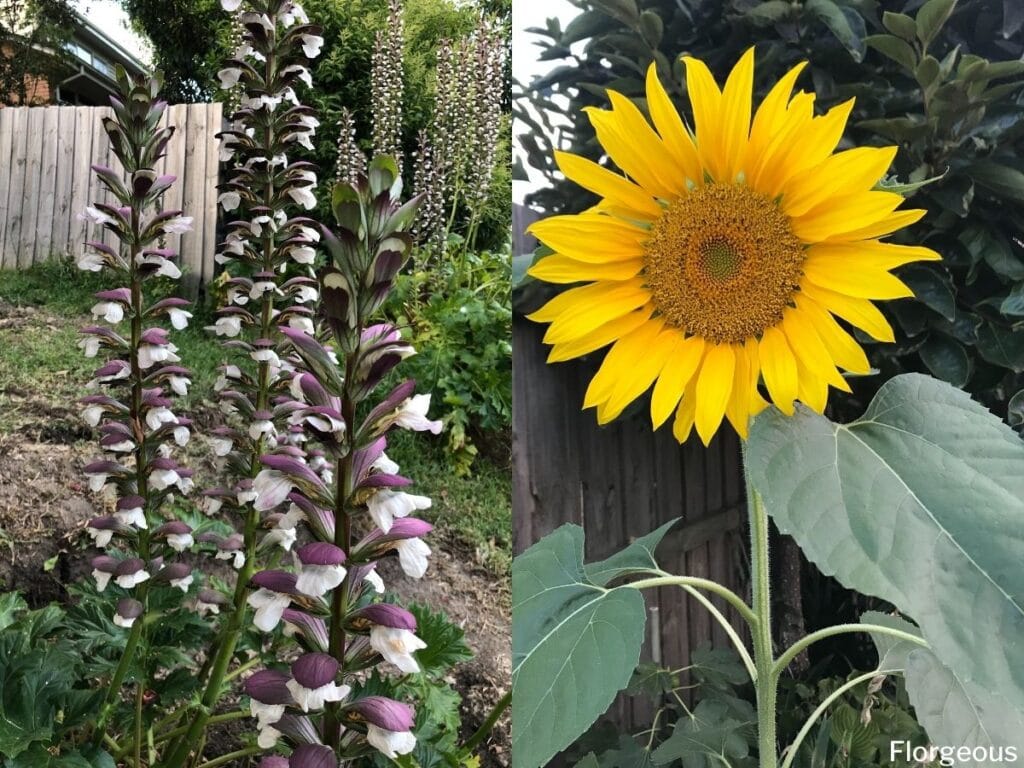What is your first thought when you see a tall flower? Bright colors, wide shades, and giant heights. Needless to say, these plants have a great garden presence.
Aside from their towering appearance, growing tall flowers has many advantages.
The primary benefit of tall height is that of creating a good environment for pollinators, attracting them away from other plants, therefore promote outcrossing.
But tall plants would not be complete without their numerous flowers, which exist in many shapes and features. Taller plants are a great meeting point for beneficial insects and bugs alike, creating the ideal environment for pollinators.
Why Choose Tall Flowers?
Aside from their aesthetics, you can use tall flowers to add more vertical features to your landscape, especially along fences or gates. They are also a great backdrop for shorter plants or even a shelter for wildlife.
Growing tall flowers requires more attention than tiny flowering plants, but you will soon realize that it is all worth it!
The Best Tall Flowering Plants to Grow
Although most tall plant blooms are easy to grow, you may want to consider plants that suit your location, overall temperature, and soil type.
Read below to learn more about what tall flower meets your needs.
#1. Bear’s breeches

The Acanthus mollis, also known as sea dock, bear’s breeches, bear’s foot plant is one of the tallest perennial flowers.
This plant produces white flowers and requires moist well drained soil to grow. It can thrive in both full sun and partial shade.
#2. Floss Flower (Ageratum)
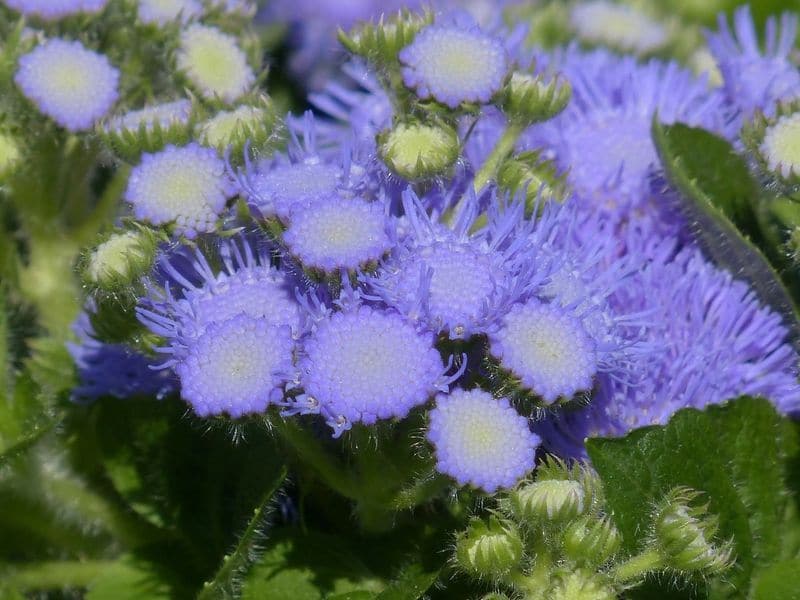
The Ageratum genus includes 40 different varieties of flowering plants, both annual and perennial. This genus is native to tropical regions of North and South America. The most common flower that belongs to this genus is named floss flower, for its eccentric pompom-shaped flowers.
The Ageratum offers flowers of various heights, ranging from 6” to 30”. What makes these blooms so unique is their bright blue shade, highly craved by avid gardeners.
You can buy these bedding plants in tray packs, though you can also grow them from seed. Since its size varies, you may choose to plant ageratum in containers, use it as edging along pathways, or simply display it in mass.
Floss flowers like the bright sun. If there is too much shade or insufficient air circulation, fungal diseases will occur, especially powdery mildew. But do not swamp the soil either! Too much water will lead to crown and root rot.
If you plant them in the ideal site, ageratums will resist most pests and diseases. Simply make sure the soil is rich and well-drained and provide water at least once a week. Doing so will also attract pollinators butterflies, and hummingbirds.
#3. Amaranth
Amaranth is an easy-to-grow herbaceous plant that can be annual or perennial. The Greeks named this flower amárantos, unfading. This is because amaranths keep their color after they dry, so their beauty never fades away.
If you are looking for dried flowers, Amaranth is the perfect option. They come in a variety of colors, from lavender to white and pink, making them the target of many butterflies. They commonly reach 1 to 2 inches in height, although some bushes can grow up to 6 inches.
Some varieties of amaranth are grown and harvested for food. If you are looking for more reasons to grow an amaranth flower plant, just know that its leaves make delicious spinach, and the seeds have fed populations all over the world, from Central and Latin America to India and China.
These tall perennials are easy to grow from seed. If you live in a cooler climate, start growing them indoors, then transplant them into the garden when the seedlings reach around 6 inches. Make sure you keep the soil moist and well-drained.
#4. Spider Flower (Cleome)

Cleome is commonly known as the spider flower for its tall appearance and long, uniquely shaped leaves. Dashing bright colors complement the intricate design of its colorful flowers.
Cleome flowers bloom in the early summer and may last until temperatures get colder. You can use some varieties of the plant as a background for shorter flowers or as stand-alone specimens if you choose to plant cleome in masses.
When the perennial plants reach a height of 1 foot, you will start seeing the first blooms. As it grows in height, more flowers will appear at the top of the plants. Some of the branches along the way produce even more brightly colored flowers.
What is great about this plant is that it easily self-seeds. You will only need to plant cleome in your chosen location once, and they will re-seed prolifically, blooming year after year. The spider flower grows best in full sun and well-drained soil.
Once they are fully grown, they will be more tolerant to drought and will hold up well during summer’s heat. A great advantage of cleomes is that they attract beneficial bugs and prevent bad insects from damaging crops.
#5. Tithonia (Mexican Sunflower)
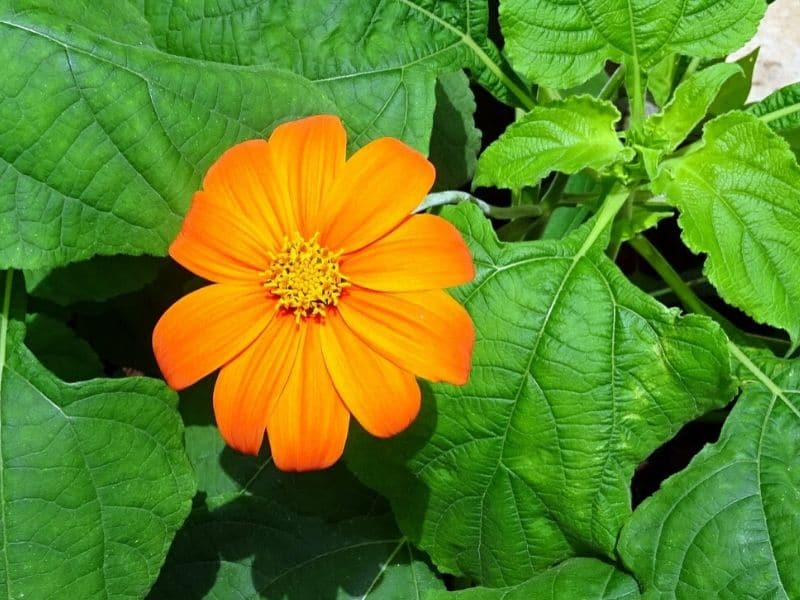
Though it is not commonly grown in gardens, the Mexican Sunflower is worth mentioning for its bright orange flowers and for being essentially pest-free. The genus Tithonia includes at least ten species of annuals and perennials originating from Central America and Mexico.
Otherwise known as the torch flower, the Mexican sunflower is a great addition to your garden. It adds height to displays, being almost 6” tall. Its vibrant flowers bloom from late summer to early fall, but the seeds take a while to flourish.
If you do not want to wait too long for the Mexican sunflower to bloom, you can start planting the seeds indoors, pressing them well against the soil. But make sure the frosty days are over before transferring it outside; they love hot days.
These tall perennial flowers are an attractive target for hummingbirds, bees, and butterflies. Beneficial insects and other pollinators are frequent visitors of this perennial flower as well. Just be careful with the weather: shelter the tithonia from strong winds and water well during dry periods.
#6. Sunflowers
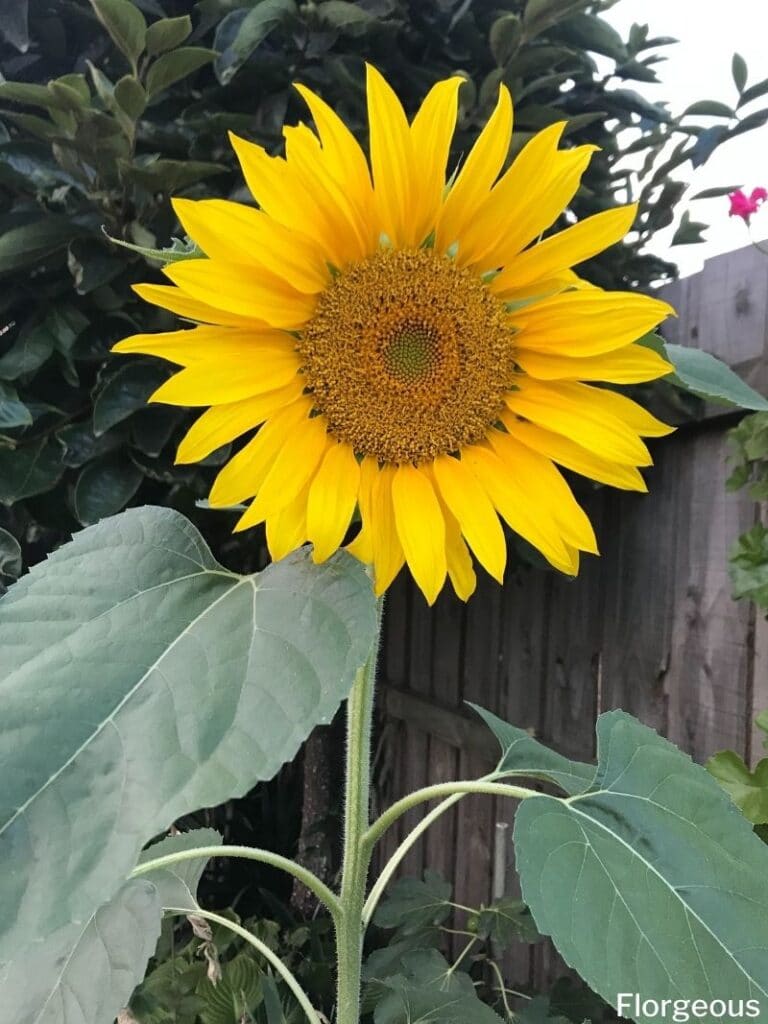
With classic sunflowers, you can never go wrong! These daisy-like flower faces are probably the first flowers you think of when you are shopping for tall annuals. They belong to the genus of Helianthus annuus, from the Greek words Helios and Anthos.
Although sunflowers come in many colors, you may be familiar with their bright yellow with brown centers ripen into heavy heads filled with seeds. Their diameter can extend up to 1 foot.
Sunflowers are heliotropic: they turn from east to west based on the movement of the sun and then return to facing east at night, ready again for the morning sun.
Most sunflower types mature in only 80 to 95 days and their height ranges from 1 foot to 16 feet tall! As there are many varieties available on the market, you will always be able to find the one that is best for you.
If you choose to grow sunflower seeds, you can start indoors before transporting them outdoors. But since they grow very quickly, you should plant the seeds directly into the garden soil, without affecting the growth of the roots.
Once your perennial plant has fully grown, start watering it at consistent intervals. Sunflowers do not need constant water, but if you notice particularly dry weather, make sure the water supplies do not lack.
In terms of diseases, sunflowers are mostly insect-free. However, downy mildew, rust, and powdery mildew can still affect the plant. If you spot a fungal disease in advance, apply a garden fungicide as quickly as possible to minimize the damage.
#7. Tall Verbena
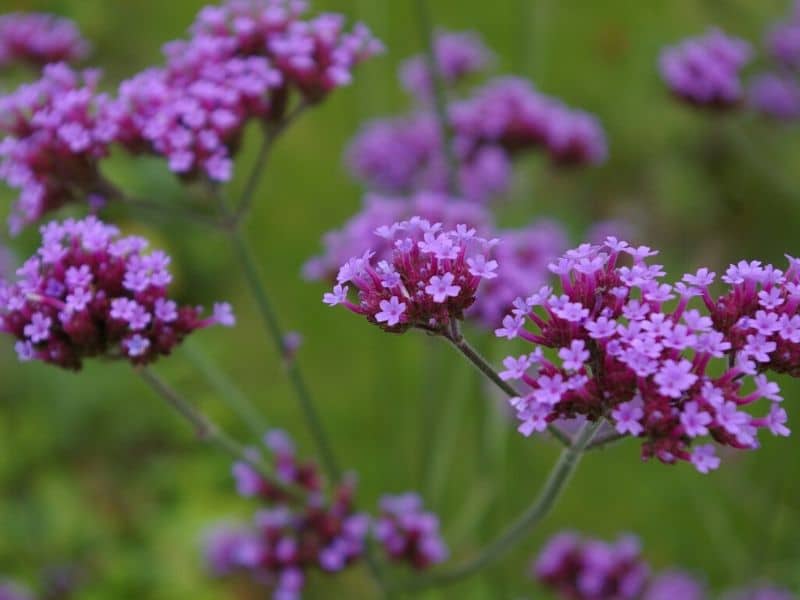
Sometimes known as Brazilian vervain, tall verbena is a native South American plant characterized by tall and slender perennial stems. The name of this plant truly says it all!
It is mostly known for having bright lilac flowers that bloom in the summer until the early freezing days—but most of all, it is known for growing to towering, statuesque heights.
If you plant it on its own, it will not be anything special. But if you let it mingle with the rest of your garden, everyone will ask you about it!
These tall flowering perennials can reach up to 6” in height. If you pinch its branches when they are about 4 feet, you will encourage a faster and stronger branching. The strong stems support clusters of lilac flowers in rounded shapes, and they are perfect for mid-borders or herbaceous borders.
This outstanding annual or perennial does not go unnoticed. Its slender stems make a strong architectural statement, making them easy targets for bees and butterflies.
Growing Verbenas is easy. Given their origin in warm territories, this genus goes well with open and sunny sites. Bear in mind that well-drained soil is essential for this flowering plant. So, make sure you keep it moist and always exposed to sunlight.
#8. Foxtail Lily (Desert Candle)
Foxtail lilies belong to the genus Eremurus, which includes more than 40 species of plants that originated in Central Asia’s rocky areas.
Due to the mountainous environment in which they grow, foxtail lilies are also named desert candles. These fast-growing flower plants can reach up to 8 feet in height, and you can distinguish them from their warm colors: yellow, orange, and coral.
To encourage the best blooms, foxtail lilies require a period of cold weather, so you should start planting the seeds in the fall. These perennials’ flower spikes will then bloom in June or July.
Bees are very attracted to the star-shaped flowers coming out of these spikes.
If you are looking for a plant that adds height at the back of a border, then foxtail lilies should be your go-to plant. They need to grow in full sun, so just plant them at the back of a sunny border, making sure the soil is well-drained.
While they can stand some shade, if the area is too isolated from the sun the stems will not grow strong enough to support their showy flowers. Foxtail lilies do not need high amounts of water, but always ensure the soil never dries out.
Word of warning: foxtail lilies contain cyanogenic glycosides, so they are poisonous to people and livestock. Handle this plant with care!
#9. Zinnia
Zinnia flowers belong to the genus of the sunflower tribe and the daisy family. This plant originated in the Southwestern United States and South America.
If you opted for zinnias, there are three main types of flowers to choose from:
- Single-flowered: Their center is visible and with only one single row of petals.
- Double-flowered: There are multiple rows of petals, but their center is less visible
- Semi double-flowered: These are a middle ground, having more than one row of petals but visible centers.
In addition to the forms listed above, these flowers come in other shapes such as “beehive,” “button,” and “cactus.”
These plants also come in different heights, so you can choose the measurement that best fits your needs. You can use taller sizes in the background of a garden bed, while shorter sizes work well along an edge or fence. So, you will find a zinnia for every flower garden!
Zinnias are really easy to grow; your garden will burst into colors in no time! They grow quickly, so be sure to know exactly what to do when they bloom.
You should start growing zinnias right into the garden bed. If you transplant them at a later time, their roots will not get strong enough. From the seeds, they can bloom very quickly. Choose a location that gets full sun and enrich the soil with compost for faster growth!
Zinnias are annual flower plants: they will grow and produce seeds for one season, but you will no longer see the original plant in subsequent years. The bright flower heads placed on an erect stem make them great for a cutting flower or to feed butterflies.
What Should I Grow With Tall Flowers?
As you read through this guide, tall flower plants do much more than just adding height to your garden.
Tall flowers can be a beautiful backdrop for smaller plants and can quickly bring more privacy to your backyard or pool. They can even distract from an ugly fence or an old wall!
Other than being a great design addition, these plants improve the health and quality of your garden by attracting pollinators and keeping bad insects away from your green area.
If you ever plan on growing some tall flower plants, rest assured that you will not be disappointed. Grab a sturdy shovel and a tape measure and start seeing those stems grow tall and towering!
FAQs
What are the largest flower types?
The largest flower types include the Rafflesia arnoldii, known for producing the largest individual flowers that can reach up to three feet (about one meter) in diameter. Another notable large flower type is the Titan arum (Amorphophallus titanum), also called the “corpse flower,” known for its immense size and distinctive odor. Both of these flowers are remarkable for their unusual characteristics and are found in specific regions of the world.
What is the largest and tallest flower?
The Titan arum (Amorphophallus titanum), commonly known as the “corpse flower,” holds the record for the largest unbranched inflorescence, which means a cluster of flowers on a single stem. While not the tallest flower in terms of stem height, the Titan arum’s inflorescence can reach an impressive height of over 10 feet (3 meters). This tropical plant is renowned for its enormous size and the pungent odor it emits during its brief flowering period.
Check our blog for all different types of flowers to grow.

